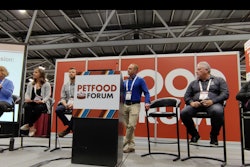
Computers can model a particular pet food formulation before producing a single kibble. Computer models help pet food producers to plan and prepare more effectively while developing products manufacturers know they can make consistently. At Petfood Forum 2024, Ian Mealy, product marketing director for Format Solutions, delivered a Tech Talk on the transformative potential of formulation software in the pet food industry. Mealy discussed how these digital tools can model real-world pet food production to enhance productivity and efficiency.
Mealy began by contextualizing the essential IT infrastructure that supports daily operations in pet food businesses, including enterprise resource planning (ERP), supply chain management and manufacturing execution systems. He emphasized the critical role of product lifecycle management (PLM), where formulation truly comes into play. According to Mealy, PLM is not just a system but a concept that encompasses the management of products from conception to delivery, with the recipe at its core.
He highlighted the capability for formulation automation as a critical differentiator. Mealy pointed out that traditional PLM and recipe management systems might produce satisfactory recipes but often fall short in accounting for real-life challenges such as ingredient variability. Formulation software, leveraging algorithms, addresses these issues by generating recipes that meet business goals cost-effectively. This automation ensures consistency in product quality and allows businesses to adapt swiftly to changing circumstances.
Mealy addressed a common misconception about formulation being synonymous with reduced quality due to the "least cost" connotation. He argued that formulation should be viewed as a strategic tool that brings control and precision to recipe development, thus ensuring high-quality outputs despite real-world variability.
Software modeling of pet food formulation
One of the advancements Mealy discussed was the ability of formulation software, like his company’s IntegraMix, to manage and optimize complex, multi-stage recipes. This capability allows pet food manufacturers to design versatile recipes for multiple products, thereby enhancing production efficiency. The software programs can handle various moisture levels in ingredients and processes, allowing predictions of nutrition, cost and ingredient requirements.
Another critical aspect was ingredient weighing accuracy, he said. Mealy explained that ignoring the precision needed in ingredient measurements could lead to significant deviations in production. By incorporating accurate weighing into the recipe design, businesses can achieve more practical and reliable production outcomes.
Mealy concluded by underscoring the importance of integration within the technology landscape. Formulation is central to pet food production, and its effectiveness hinges on seamless data exchange across various systems. The more accurately the computer models real-world conditions, the more the software empowers businesses to respond to changes, maintaining product quality while considering cost and ingredient availability.



















